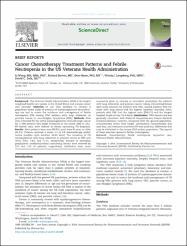Please use this identifier to cite or link to this item:
https://hdl.handle.net/20.500.11779/608| Title: | Cancer Chemotherapy Treatment Patterns and Febrile Neutropenia in the Us Veterans Health Administration |
| Authors: | Wang, Li Dale, David C Barron, Richard Langeberg, Wendy J Başer, Onur |
| Keywords: | Febrile neutropenia Supportive care Veterans health administration Chemotherapy |
| Source: | Wang, L., Barron, R., Baser, O., Langeberg, W.J. &Dale, David C. (2014). Cancer Chemotherapy Treatment Patterns and Febrile Neutiopenia in the US Veterans Health Administration. Value in Health. 17, 2, 739-743. |
| Abstract: | Background: The Veterans Health Administration (VHA) is the largest integrated health care system in the United States and a major cancer care provider. Objective: To use VHA database to conduct a population-based study of patterns of myelosuppressive chemotherapy use and to assess the incidence and management of febrile neutropenia (FN) among VHA patients with lung, colorectal, or prostate cancer or non-Hodgkin lymphoma (NHL). Methods: Data were extracted for the initial myelosuppressive chemotherapy course for 27,899 patients who began treatment in the period 2006 to 2011. FN-related costs were defined as claims containing FN diagnosis. Results: Most patients were men (98.0%); most were 65 years or older (55.8%). Patients received a mean 3.4 to 3.9 chemotherapy cycles/course (median cycle duration 34-43 days). The incidence of FN among patients with lung, colorectal, or prostate cancer or NHL was 10.2%, 4.6%, 5.4%, and 17.3%, respectively. Primary or secondary prophylactic antibiotics/colony-stimulating factors were received by 21% and 12% of patients, respectively. Antibiotics were more commonly given as primary or secondary prophylaxis for patients with lung, colorectal, and prostate cancer; colony-stimulating factors were more common for patients with NHL. Among patients with FN, those with lung cancer had the highest inpatient mortality (10%); patients with NHL had the highest costs ($24,571) and the longest hospital length of stay (15.4 days). Conclusions: VHA cancer care was generally consistent with National Comprehensive Cancer Network recommendations; however, compared with the general population, chemotherapy cycles were longer, combination chemotherapy was used less, and treatment to prevent FN was used less, differences that may be attributed to the unique VHA patient population. The impact of these practices warrants further investigation. |
| URI: | https://hdl.handle.net/20.500.11779/608 http://dx.doi.org/10.1016/j.jval.2014.06.009 |
| ISSN: | 1098-3015 |
| Appears in Collections: | Ekonomi Bölümü Koleksiyonu PubMed İndeksli Yayınlar Koleksiyonu / PubMed Indexed Publications Collection Scopus İndeksli Yayınlar Koleksiyonu / Scopus Indexed Publications Collection WoS İndeksli Yayınlar Koleksiyonu / WoS Indexed Publications Collection |
Files in This Item:
| File | Description | Size | Format | |
|---|---|---|---|---|
| WOS000342363300010.pdf | Yayıncı Sürümü - Makale | 356.77 kB | Adobe PDF |  View/Open |
CORE Recommender
Sorry the service is unavailable at the moment. Please try again later.
Items in GCRIS Repository are protected by copyright, with all rights reserved, unless otherwise indicated.